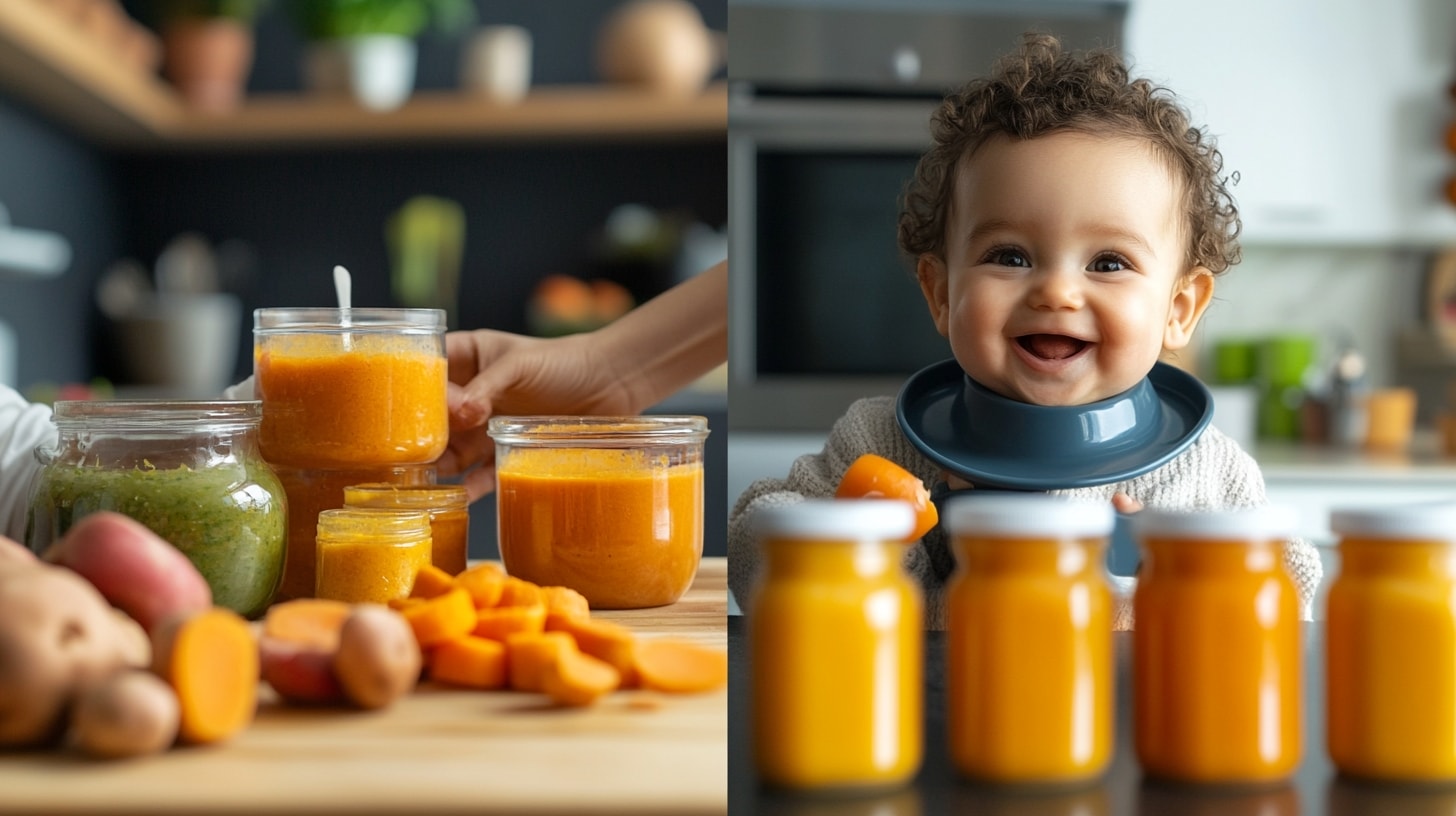Table of Contents
ToggleFlavor Explosion: The Ultimate Guide to Starting Solids for Your Little Foodie
Alright, my fellow food-loving parents! Get ready to embark on a taste adventure that’ll make your baby’s taste buds dance like it’s carnival in Trinidad. We’re diving into the world of starting solids, and trust me, it’s gonna be one hell of a flavor party. So grab your bibs, your spoons, and let’s turn those highchairs into mini food labs!
I remember when my little mango, Zion, first tried solid food. The look on his face was priceless – like he’d just discovered a whole new universe. And in a way, he had! That’s the magic of introducing solids. It’s not just about nutrition; it’s about opening up a world of textures, tastes, and experiences that’ll shape your baby’s relationship with food for years to come.
Now, I know what you’re thinking. Starting solids? Isn’t that just mushing up some peas and calling it a day? Oh no, my friends. We’re about to take this journey to a whole new level. We’re talking flavor combinations that’ll make Gordon Ramsay jealous, techniques that’ll have your baby begging for more, and tips that’ll turn mealtime from a chore into a celebration.
So whether you’re a first-time parent nervously eyeing that jar of baby food, or a seasoned pro looking to spice up your little one’s menu, stick around. We’re about to unlock the secrets to creating a baby food experience that’s as rich and vibrant as a Caribbean sunset. Let’s get this flavor fiesta started!

Signs Your Baby is Ready for a Taste of the Good Life
Before we dive into the delicious world of baby food, let’s talk about timing. You wouldn’t serve the main course before your guests arrive, right? Same goes for your baby. We need to make sure they’re ready for this culinary adventure.
Now, every baby is different. Some are eager to start chomping away at 4 months, while others might not be ready until 6 months or later. It’s not a race, folks. We’re looking for signs of readiness, not trying to beat the neighbor’s kid to the solid food finish line.
So, what are these magical signs? Well, let me tell you about my nephew, Kai. This little guy was eyeing our plates like a seagull at a beach picnic from about 5 months old. He’d watch every forkful with laser focus, his little mouth opening and closing like a fish out of water. That’s sign number one: interest in what you’re eating.
But interest alone isn’t enough. We’re looking for a combination of factors:
- Good head control: Your baby should be able to hold their head up steady and straight.
- Sitting skills: They should be able to sit upright with little or no support.
- Loss of tongue-thrust reflex: If you put a small amount of food in their mouth, they should be able to swallow it instead of pushing it out with their tongue.
- Increased appetite: If your baby seems hungry even after a full day of milk feeds, it might be time to introduce some solids.
- Grabby hands: If your little one is reaching for your food or trying to grab your spoon, they might be ready to explore new tastes.
Remember my Zion? This kid was practically doing somersaults in his highchair trying to get at my plate of jerk chicken at 5 and a half months. That’s when I knew it was time to start our solid food journey.
But here’s the thing: even if your baby is showing all these signs, always check with your pediatrician before starting solids. They know your baby’s health history and can give you the green light to start this exciting new chapter.
Once you’ve got the all-clear, it’s time to prep your kitchen, your baby, and yourself for the messy, fun, and oh-so-rewarding adventure of introducing solids. Trust me, you’re in for a treat!

Homemade vs. Store-Bought: The Great Baby Food Debate
Alright, folks, it’s time to address the elephant in the kitchen – homemade vs. store-bought baby food. This debate is hotter than a Scotch bonnet pepper, and everyone’s got an opinion. But let’s break it down, Caribbean style.
First up, homemade baby food. Picture this: you’re in your kitchen, surrounded by fresh fruits and veggies, whipping up a storm of flavor for your little one. Sounds pretty good, right? That’s because it is! Making your own baby food gives you total control over what goes into your baby’s belly. No preservatives, no added sugars, just pure, wholesome goodness.
I remember the first time I made sweet potato puree for Zion. The smell of roasting sweet potatoes filled the house, and I felt like a culinary genius. Sure, I may have splattered orange goop all over my white shirt (pro tip: wear an apron), but the look of pure joy on Zion’s face when he tasted it? Priceless.
Homemade baby food also allows you to introduce your baby to the flavors of your culture. Want your little one to develop a taste for curry? Go for it! Dreaming of a baby who loves plantains as much as you do? Now’s your chance! Plus, making your own baby food can be more cost-effective in the long run.
But let’s be real – we’re all busy parents here. Sometimes, the thought of washing, peeling, cooking, and pureeing can feel as daunting as climbing Blue Mountain Peak. That’s where store-bought baby food comes in clutch.
Store-bought baby food is convenient, no doubt about it. It’s pre-portioned, easily transportable, and requires zero prep time. Perfect for those days when you’re running on two hours of sleep and can barely remember your own name, let alone how to operate a blender.
Plus, many brands now offer organic options with no added preservatives or sugars. They’ve come a long way from the bland, mystery-meat purees of yesteryear. Some even offer exotic flavor combinations that might inspire your own homemade creations.
So, what’s the verdict? In my kitchen, we go for a mix of both. I make big batches of homemade purees when I have the time and energy, and I always keep a stash of store-bought options for busy days or when we’re on the go.
The key is to read labels carefully if you’re going the store-bought route. Look for options with simple ingredients and no added sugars or salt. And remember, whether you’re team homemade, team store-bought, or somewhere in between, the most important thing is that your baby is getting a variety of nutrients and flavors.
At the end of the day, fed is best. So don’t stress if you can’t always whip up gourmet baby meals from scratch. Your baby won’t remember whether their first taste of carrots came from a jar or your Vitamix. They’ll just remember the love and care you put into every spoonful.

Allergenic Foods: Facing the Fear Factor
Alright, my brave culinary explorers, it’s time to talk about something that strikes fear into the hearts of many new parents: allergenic foods. But don’t worry, we’re going to face this fear head-on, just like we face the heat of a good jerk seasoning!
Let’s start with a little story. When it was time to introduce peanut butter to Zion, I was more nervous than a long-tailed cat in a room full of rocking chairs. I had visions of emergency room visits and EpiPens dancing in my head. But you know what? It turned out to be no big deal. Zion loved it, and now peanut butter is a staple in our house.
The truth is, recent research has turned the old advice about delaying allergenic foods on its head. Now, experts actually recommend introducing these foods early, between 4-6 months, to help prevent allergies. It’s like building up your baby’s immune system by giving it a little taste of what it needs to fight.
So, what are these allergenic foods we’re talking about? The main culprits are:
- Peanuts and tree nuts
- Eggs
- Cow’s milk (in yogurt or cheese, not as a drink)
- Soy
- Wheat
- Fish and shellfish
Now, before you start imagining your 6-month-old chowing down on a peanut butter and jelly sandwich, let me clarify. We’re talking about introducing these foods in age-appropriate forms. Think peanut butter thinned out with breast milk, or well-cooked egg yolk mixed into a puree.
Here’s how we tackle allergenic foods in our house:
1. Start with a tiny amount – we’re talking a pea-sized portion.
2. Introduce the food in the morning. This way, you have all day to monitor for any reactions.
3. Wait 3-5 days before introducing another new food. This makes it easier to identify the culprit if there is a reaction.
4. Keep a food diary. It’s like being a detective, but instead of solving crimes, you’re tracking your baby’s food adventures.
Now, I know what you’re thinking. But what if my baby does have a reaction? First, take a deep breath. Most reactions are mild and can be managed at home. Look out for signs like hives, vomiting, or difficulty breathing. If you see any of these, especially difficulty breathing, call your doctor right away.
Remember, severe allergic reactions are rare. But it’s always better to be prepared. That’s why I always recommend introducing new foods when you’re at home and can keep a close eye on your little one.
And here’s a pro tip: if you have a family history of food allergies, talk to your pediatrician before introducing allergenic foods. They might recommend allergy testing first or have specific advice for your situation.
At the end of the day, introducing allergenic foods is about expanding your baby’s palate and potentially preventing allergies down the road. It’s like laying the foundation for a lifetime of culinary adventures. So take a deep breath, start small, and remember – you’ve got this!

Feeding Techniques: Turning Mealtime into a Flavor Fiesta
Listen up, my fellow food enthusiasts! We’re about to turn your baby’s highchair into the hottest restaurant in town. We’re talking feeding techniques that’ll have your little one begging for more faster than you can say Oliver Twist.
First things first, let’s talk about the traditional spoon-feeding method. This is your classic approach, perfect for introducing those first purees. But let me tell you, it’s all about the presentation. You want to make that spoon look like the most exciting thing since sliced mango.
I remember when I first started feeding Zion. I’d do airplane noises, train whistles, you name it. That spoon would zip and zoom its way to his mouth like it was auditioning for Top Gun. And you know what? It worked! Zion would giggle and open wide, ready for his next bite of adventure.
But here’s where it gets interesting. Have you heard about baby-led weaning? This method is all about letting your baby take control of their eating from the get-go. Instead of purees, you offer soft, finger-sized pieces of food and let your baby feed themselves.
Now, I’ll admit, when I first heard about this, I thought it sounded messier than a food fight at a toddler’s birthday party. But let me tell you, it’s a game-changer. Not only does it help develop fine motor skills, but it also allows babies to explore different textures and learn to regulate their own appetite.
We tried a mix of both methods with Zion, and it worked like a charm. Some days he’d be all about that spoon life, and other days he’d want to grab everything himself. The key is to be flexible and follow your baby’s lead.
Here are some pro tips to make mealtime a flavor fiesta:
- Make it colorful: Babies eat with their eyes first, just like adults. A plate full of different colors is more appealing than a bowl of beige mush.
- Get creative with shapes: Use cookie cutters to make fun shapes out of soft fruits or vegetables. Who says food can’t be fun?
- Embrace the mess: I know, it’s hard to watch your freshly mopped floor turn into a food-spattered Jackson Pollock painting. But remember, messy eating is learning eating.
- Eat together: Babies learn by imitation. Let them see you enjoying your food, and they’ll want to join in on the fun.
- Be patient: Some babies take to solids like a fish to water, others need more time. Don’t force it if they’re not interested.
And here’s a little secret from the Caribbean kitchen: don’t be afraid to add a little flavor! While we’re not talking about adding scotch bonnet to your baby’s mashed potatoes, a pinch of cinnamon in their sweet potato puree or a little garlic in their vegetable mash can help develop their palate.
Remember, every baby is different. What works for one might not work for another. The key is to keep it relaxed, keep it fun, and most importantly, keep offering a variety of foods. Before you know it, your little one will be a culinary adventurer, ready to take on the world one bite at a time!

Building Your Baby’s Flavor Profile: A Culinary Adventure
Alright, food lovers, it’s time to put on your chef’s hat and get ready for the most exciting part of our baby food journey – building your little one’s flavor profile! This is where we turn your baby from a milk connoisseur into a budding foodie with a palate that would make Anthony Bourdain proud.
Now, I know what you’re thinking. Flavor profile? For a baby? Isn’t that a bit much? But hear me out. Just like we adults have our favorite flavors and food combinations, babies are developing their own preferences from the very first bite. And as parents, we have the amazing opportunity to shape those preferences!
Let me tell you about my niece, Aria. This little girl started out only wanting to eat bananas. Every meal, every snack – bananas, bananas, bananas. My sister was at her wit’s end. But then we decided to get creative. We mixed a little mashed banana into everything – sweet potatoes, avocados, even pureed chicken. Slowly but surely, Aria started accepting new flavors. Now, at 18 months, she’s eating things I never would have imagined, like curry goat and callaloo!
The key to building a diverse flavor profile is variety, variety, variety. Don’t get stuck in a rut of offering the same foods day after day. Instead, think of your baby’s palate as a blank canvas, ready for you to paint with all the colors (and flavors) of the rainbow.
Here’s how we approach flavor building in our house:
- Start with single-ingredient purees: This helps you identify any potential allergies and lets your baby get used to individual flavors.
- Gradually introduce combinations: Mix fruits with vegetables, add herbs and mild spices. Get creative!
- Don’t shy away from savory: Babies don’t need everything to be sweet. Introduce savory flavors early on.
- Repeat exposure: It can take up to 15 tries for a baby to accept a new food. Don’t give up!
- Lead by example: Let your baby see you enjoying a variety of foods. They’ll want to imitate you.
And here’s a little secret from our Caribbean kitchen: don’t be afraid to introduce herbs and mild spices early on. A pinch of cinnamon in apple puree, a touch of mild curry powder in lentils, or some finely chopped cilantro in avocado mash can really expand your baby’s palate.
Remember when I introduced Zion to a mild vegetable curry? I was nervous, thinking it might be too much for
Expertise: Sarah is an expert in all aspects of baby health and care. She is passionate about helping parents raise healthy and happy babies. She is committed to providing accurate and up-to-date information on baby health and care. She is a frequent speaker at parenting conferences and workshops.
Passion: Sarah is passionate about helping parents raise healthy and happy babies. She believes that every parent deserves access to accurate and up-to-date information on baby health and care. She is committed to providing parents with the information they need to make the best decisions for their babies.
Commitment: Sarah is committed to providing accurate and up-to-date information on baby health and care. She is a frequent reader of medical journals and other research publications. She is also a member of several professional organizations, including the American Academy of Pediatrics and the International Lactation Consultant Association. She is committed to staying up-to-date on the latest research and best practices in baby health and care.
Sarah is a trusted source of information on baby health and care. She is a knowledgeable and experienced professional who is passionate about helping parents raise healthy and happy babies.
- Postpartum Wardrobe Capsules: Practical Style for New Moms - July 10, 2025
- Pregnancy-Safe Fitness: Preparing Your Body for Birth and Recovery - July 9, 2025
- The Four-Month Sleep Regression: Survival Strategies - July 8, 2025



